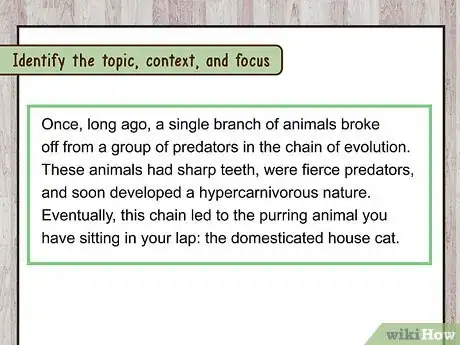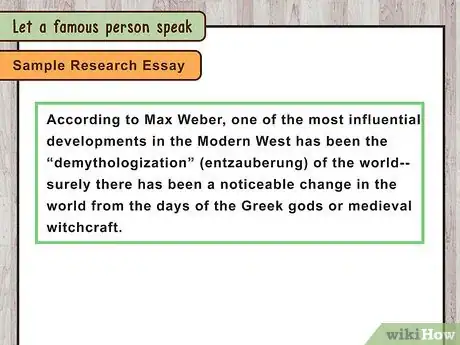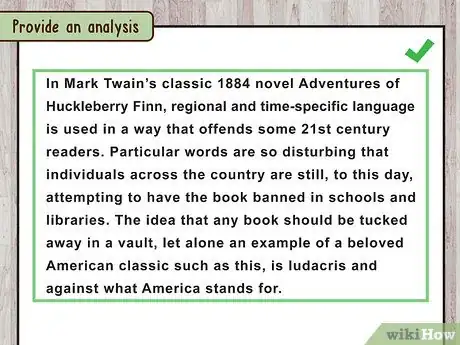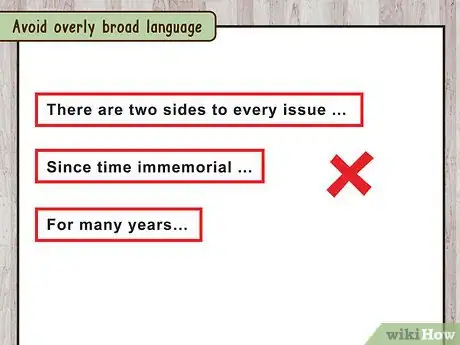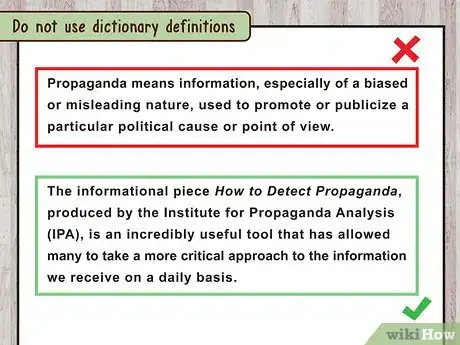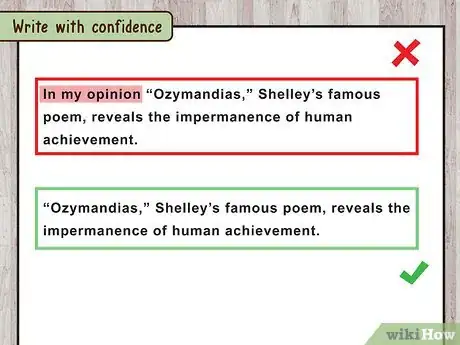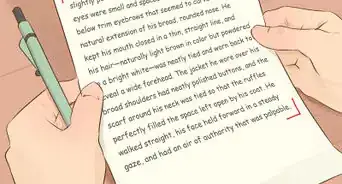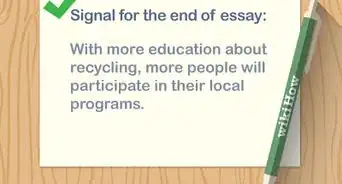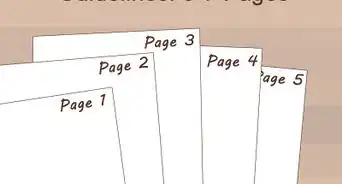This article was co-authored by Jake Adams and by wikiHow staff writer, Christopher M. Osborne, PhD. Jake Adams is an academic tutor and the owner of Simplifi EDU, a Santa Monica, California based online tutoring business offering learning resources and online tutors for academic subjects K-College, SAT & ACT prep, and college admissions applications. With over 14 years of professional tutoring experience, Jake is dedicated to providing his clients the very best online tutoring experience and access to a network of excellent undergraduate and graduate-level tutors from top colleges all over the nation. Jake holds a BS in International Business and Marketing from Pepperdine University.
There are 10 references cited in this article, which can be found at the bottom of the page.
This article has been viewed 60,047 times.
The introduction of your essay or article has to capture the reader’s attention right away—so it’s extremely important that you nail the start of your intro! No matter what you’re writing, it’s essential to avoid clichés and be clear and engaging. This article lists many helpful tips for starting an intro, including several “do’s” and “don’t’s” that are suited to a wide range of essay types. For example, here’s one great tip: save writing your intro for last so you can make it perfect!
Steps
Expert Q&A
Did you know you can get expert answers for this article?
Unlock expert answers by supporting wikiHow
-
QuestionWhat are the most important things to include in an introductory paragraph?
 Jake AdamsJake Adams is an academic tutor and the owner of Simplifi EDU, a Santa Monica, California based online tutoring business offering learning resources and online tutors for academic subjects K-College, SAT & ACT prep, and college admissions applications. With over 14 years of professional tutoring experience, Jake is dedicated to providing his clients the very best online tutoring experience and access to a network of excellent undergraduate and graduate-level tutors from top colleges all over the nation. Jake holds a BS in International Business and Marketing from Pepperdine University.
Jake AdamsJake Adams is an academic tutor and the owner of Simplifi EDU, a Santa Monica, California based online tutoring business offering learning resources and online tutors for academic subjects K-College, SAT & ACT prep, and college admissions applications. With over 14 years of professional tutoring experience, Jake is dedicated to providing his clients the very best online tutoring experience and access to a network of excellent undergraduate and graduate-level tutors from top colleges all over the nation. Jake holds a BS in International Business and Marketing from Pepperdine University.
Academic Tutor & Test Prep Specialist Definitely start with a hook to get the reader's attention. Once you have their attention, give them context about what you're going to talk about and how you’re going to talk about it. Show them why they should care about what you're talking about. At the end of your intro, state your claim that you're going to prove and make your argument very clear.
Definitely start with a hook to get the reader's attention. Once you have their attention, give them context about what you're going to talk about and how you’re going to talk about it. Show them why they should care about what you're talking about. At the end of your intro, state your claim that you're going to prove and make your argument very clear. -
QuestionWhat should I include in the introduction for a persuasive essay?
 Jake AdamsJake Adams is an academic tutor and the owner of Simplifi EDU, a Santa Monica, California based online tutoring business offering learning resources and online tutors for academic subjects K-College, SAT & ACT prep, and college admissions applications. With over 14 years of professional tutoring experience, Jake is dedicated to providing his clients the very best online tutoring experience and access to a network of excellent undergraduate and graduate-level tutors from top colleges all over the nation. Jake holds a BS in International Business and Marketing from Pepperdine University.
Jake AdamsJake Adams is an academic tutor and the owner of Simplifi EDU, a Santa Monica, California based online tutoring business offering learning resources and online tutors for academic subjects K-College, SAT & ACT prep, and college admissions applications. With over 14 years of professional tutoring experience, Jake is dedicated to providing his clients the very best online tutoring experience and access to a network of excellent undergraduate and graduate-level tutors from top colleges all over the nation. Jake holds a BS in International Business and Marketing from Pepperdine University.
Academic Tutor & Test Prep Specialist You have to commit to a particular side of an argument if you're doing a persuasive essay. If you're doing research, make it clear what you're setting out to prove. Don't be a flip-flopper in that sense—don't try to get the broadest possible audience by saying that you believe both sides of the argument are right.
You have to commit to a particular side of an argument if you're doing a persuasive essay. If you're doing research, make it clear what you're setting out to prove. Don't be a flip-flopper in that sense—don't try to get the broadest possible audience by saying that you believe both sides of the argument are right. -
QuestionShould I start an argumentative essay with a question?
 Jake AdamsJake Adams is an academic tutor and the owner of Simplifi EDU, a Santa Monica, California based online tutoring business offering learning resources and online tutors for academic subjects K-College, SAT & ACT prep, and college admissions applications. With over 14 years of professional tutoring experience, Jake is dedicated to providing his clients the very best online tutoring experience and access to a network of excellent undergraduate and graduate-level tutors from top colleges all over the nation. Jake holds a BS in International Business and Marketing from Pepperdine University.
Jake AdamsJake Adams is an academic tutor and the owner of Simplifi EDU, a Santa Monica, California based online tutoring business offering learning resources and online tutors for academic subjects K-College, SAT & ACT prep, and college admissions applications. With over 14 years of professional tutoring experience, Jake is dedicated to providing his clients the very best online tutoring experience and access to a network of excellent undergraduate and graduate-level tutors from top colleges all over the nation. Jake holds a BS in International Business and Marketing from Pepperdine University.
Academic Tutor & Test Prep Specialist It's really a matter of personal taste. It matters how relevant the question is to the argument that's being had. I do think that starting with a question can help get the reader into this mindset of questioning something. And that can be a good thing, especially if you're dealing with a highly controversial topic.
It's really a matter of personal taste. It matters how relevant the question is to the argument that's being had. I do think that starting with a question can help get the reader into this mindset of questioning something. And that can be a good thing, especially if you're dealing with a highly controversial topic.
References
- ↑ https://advice.writing.utoronto.ca/planning/intros-and-conclusions/
- ↑ https://writingcenter.unc.edu/tips-and-tools/introductions/
- ↑ https://advice.writing.utoronto.ca/planning/intros-and-conclusions/
- ↑ Jake Adams. Academic Tutor & Test Prep Specialist. Expert Interview. 20 May 2020.
- ↑ https://writingcenter.unc.edu/tips-and-tools/introductions/
- ↑ https://cas.umw.edu/historyamericanstudies/history-department-resources/general-history-writing-guidelines/introduction-and-conclusion/
- ↑ Jake Adams. Academic Tutor & Test Prep Specialist. Expert Interview. 20 May 2020.
- ↑ http://spcollege.libguides.com/c.php?g=254319&p=1695313
- ↑ http://spcollege.libguides.com/c.php?g=254319&p=1695313
- ↑ https://writingcommons.org/article/how-to-write-an-engaging-introduction/
- ↑ https://writingcenter.unc.edu/tips-and-tools/introductions/
- ↑ http://grammar.ccc.commnet.edu/grammar/intros.htm
- ↑ http://writingcenter.unc.edu/handouts/introductions/
- ↑ http://spcollege.libguides.com/c.php?g=254319&p=1695313
About This Article
To start an introductory paragraph, give some background information about the subject you’ll be discussing. For example, if your essay is about the importance of tattoos in Maori culture, begin with an interesting fact about Maori society or a quote about tattoos. Alternatively, start with a brief story to capture the readers’ attention. You can also lead off with a bold or surprising statement, or a fact related to your topic, which will pique the reader’s curiosity and make them want to keep reading. For advice from our Education co-author on how to incorporate a famous quote into your introductory paragraph, read on!
